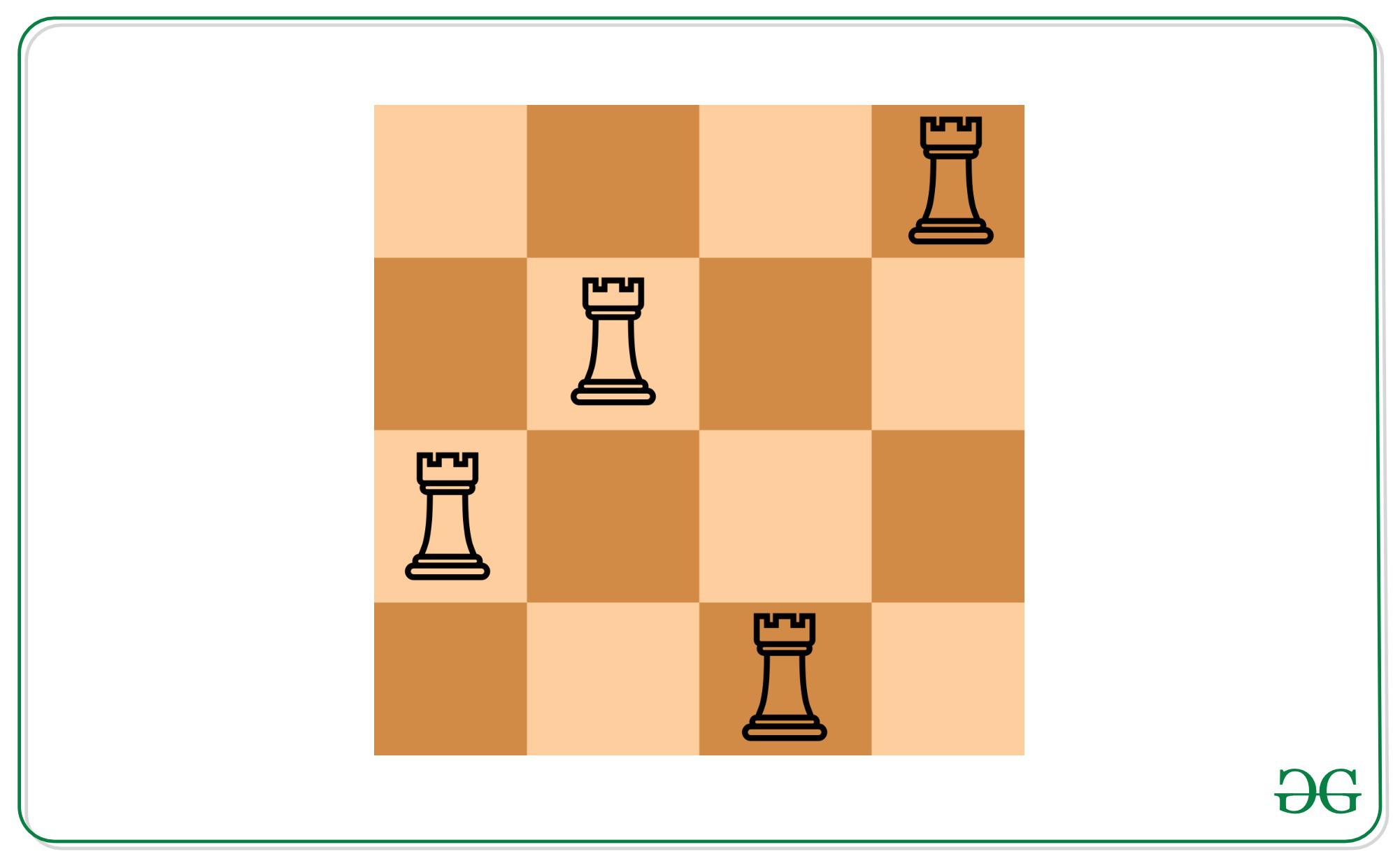Find position of non-attacking Rooks in lexicographic order that can be placed on N*N chessboard
Last Updated :
07 Mar, 2022
Given an integer N and an array arr[] of positions which denotes the positions of already placed non-attacking rooks, the task is to find the positions of non-attacking rooks in lexicographic order that can be placed on N*N chessboard.
Movement of Rooks: Any rook can move horizontally or vertically by any number of unoccupied squares.
Examples:
Input: N = 4, arr[] = {(1, 4), (2, 2)}
Output: 2
3 1
4 3
Explanation:
There can be two more rooks can be placed on the 4*4 Chessboard

Input: N = 5, arr[] = {}
Output: 5
1 1
2 2
3 3
4 4
5 5
Naive Approach: Initialize a 2D Matrix mat[][] of size N*N with 0 at every cell and mark as rooks for initially positions of Rooks by 1. Then traverse through matrix mat[][], checking whether ith row and jth column contains any rook, Keeping a count of rooks placed. If any row contains and column both doesn’t contains any placed rook, then place a rook there and add this cell to your result String.
Finally, print count of rooks placed and positions of the rooks placement
Time Complexity: O(N3)
Space Complexity: O(N2)
Efficient Approach: The idea is to create two arrays of N size each, to store whether ith row or ith column contains any rook or not and it will now become efficient to search whether this row and the corresponding column already contains Rook or not.
Time Complexity: O(N2)
Space Complexity: O(N)

Most Efficient Approach: The key observation in the problem is that the maximum rook that can be placed is N-K. That is, Two rooks attack each other if they’re on the same row or on the same column. Since no two of the given rooks attack each other, all of the rows given in the input are unique. Similarly, all of the columns given in the input are unique. So, we’re left with N-K unused rows and N-K unused columns to put the new rooks on.
In other words, if we try to put more than N-K rooks by Pigeonhole Principle, if there are N+1 pigeons and N places to fill, then at least one place contains more than 1 pigeon.
And to find the lexicographically minimum answer. This answer can be achieved by pairing the smallest unused row with the smallest unused column, the second smallest unused row with the second smallest unused column and so on.
Time Complexity: O(N)
Below is the implementation of the above approach:
C++
#include <bits/stdc++.h>
using namespace std;
void findCountRooks(int row[], int col[],
int n, int k)
{
int res = n - k;
cout << res << "\n";
int ri = 0, ci = 0;
while (res-- > 0)
{
while (ri < k && row[ri] == 1)
{
ri++;
}
while (ci < k && col[ci] == 1)
{
ci++;
}
cout << (ri + 1) << " "
<< (ci + 1) << "\n";
ri++;
ci++;
}
}
int main()
{
int n = 4;
int k = 2;
int row[] = { 1, 2 };
int col[] = { 4, 2 };
findCountRooks(row, col, n, k);
return 0;
}
|
Java
import java.util.Scanner;
public class P2Placerooks {
static void findCountRooks(
int row[], int col[], int n, int k)
{
int res = n - k;
System.out.println(res + " ");
int ri = 0, ci = 0;
while (res-- > 0) {
while (ri < k && row[ri] == 1) {
ri++;
}
while (ci < k && col[ci] == 1) {
ci++;
}
System.out.println((ri + 1)
+ " " + (ci + 1)
+ " ");
ri++;
ci++;
}
}
public static void main(String[] args)
{
int n = 4;
int k = 2;
int row[] = { 1, 2 };
int col[] = { 4, 2 };
findCountRooks(row, col, n, k);
}
}
|
Python3
def findCountRooks(row, col, n, k):
res = n - k
print(res)
ri = 0
ci = 0
while (res > 0):
while (ri < k and row[ri] == 1):
ri += 1
while (ci < k and col[ci] == 1):
ci += 1
print((ri + 1), "", (ci + 1))
ri += 1
ci += 1
res -= 1
n = 4
k = 2
row = [ 1, 2 ]
col = [ 4, 2 ]
findCountRooks(row, col, n, k)
|
C#
using System;
class P2Placerooks{
static void findCountRooks(int []row,
int []col,
int n, int k)
{
int res = n - k;
Console.WriteLine(res + " ");
int ri = 0, ci = 0;
while (res-- > 0)
{
while (ri < k && row[ri] == 1)
{
ri++;
}
while (ci < k && col[ci] == 1)
{
ci++;
}
Console.WriteLine((ri + 1) + " " +
(ci + 1) + " ");
ri++;
ci++;
}
}
public static void Main(String[] args)
{
int n = 4;
int k = 2;
int []row = { 1, 2 };
int []col = { 4, 2 };
findCountRooks(row, col, n, k);
}
}
|
Javascript
<script>
function findCountRooks(row,col,n,k)
{
let res = n - k;
document.write(res + "<br>");
let ri = 0, ci = 0;
while (res-- > 0)
{
while (ri < k && row[ri] == 1)
{
ri++;
}
while (ci < k && col[ci] == 1)
{
ci++;
}
document.write((ri + 1) + " "
+ (ci + 1) + "<br>");
ri++;
ci++;
}
}
let n = 4;
let k = 2;
let row = [ 1, 2 ];
let col = [ 4, 2 ];
findCountRooks(row, col, n, k);
</script>
|
Performance Analysis:
- Time Complexity: O(N)
- Auxiliary Space: O(1)
Like Article
Suggest improvement
Share your thoughts in the comments
Please Login to comment...